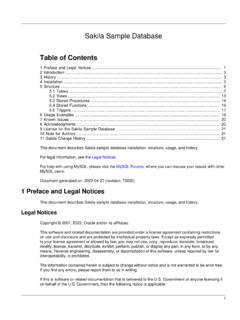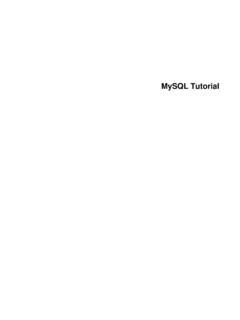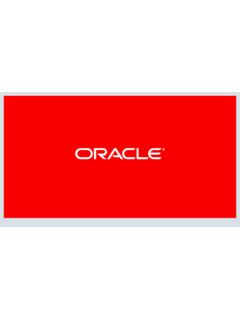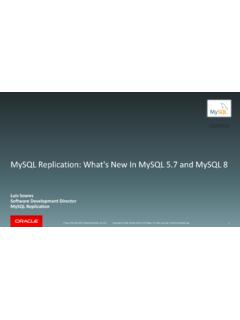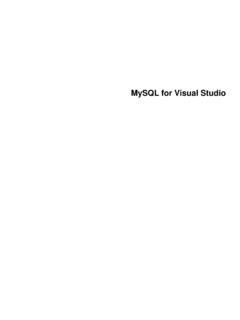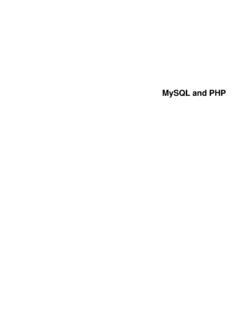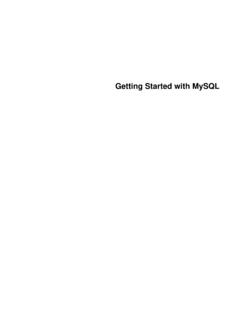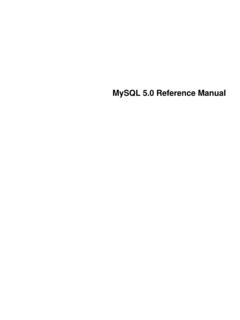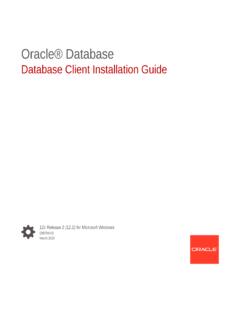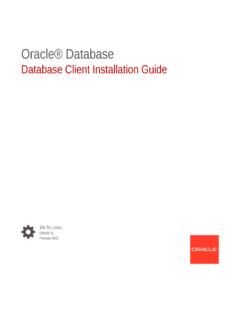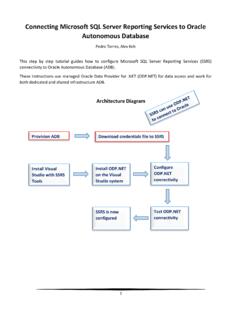Transcription of MySQL :: MySQL Tutorial
1 MySQL Tutorial Abstract This is the MySQL Tutorial from the MySQL Reference Manual. For legal information, see the Legal Notices. For help with using MySQL , please visit the MySQL Forums, where you can discuss your issues with other MySQL . users. Document generated on: 2022-01-17 (revision: 71722). Table of Contents Preface and Legal Notices .. v 1 Tutorial .. 1. 2 Connecting to and Disconnecting from the Server .. 3. 3 Entering Queries .. 5. 4 Creating and Using a Database .. 9. Creating and Selecting a Database .. 10. Creating a Table .. 11. Loading Data into a Table .. 12. Retrieving Information from a Table .. 13. Selecting All Data .. 13. Selecting Particular Rows .. 14. Selecting Particular Columns .. 15. Sorting Rows .. 16. Date Calculations .. 17. Working with NULL Values .. 20. Pattern Matching .. 21. Counting Rows .. 23. Using More Than one Table .. 25. 5 Getting Information About Databases and Tables .. 29. 6 Using MySQL in Batch Mode .. 31. 7 Examples of Common Queries .. 33.
2 The Maximum Value for a Column .. 33. The Row Holding the Maximum of a Certain Column .. 34. Maximum of Column per Group .. 34. The Rows Holding the Group-wise Maximum of a Certain Column .. 34. Using User-Defined Variables .. 35. Using Foreign Keys .. 36. Searching on Two Keys .. 38. Calculating Visits Per Day .. 38. Using AUTO_INCREMENT .. 39. 8 Using MySQL with Apache .. 43. iii iv Preface and Legal Notices This is the MySQL Tutorial from the MySQL Reference Manual. Licensing information MySQL This product may include third-party software, used under license. If you are using a Commercial release of MySQL , see the MySQL Commercial Release License Information User Manual for licensing information, including licensing information relating to third- party software that may be included in this Commercial release. If you are using a Community release of MySQL , see the MySQL Community Release License Information User Manual for licensing information, including licensing information relating to third-party software that may be included in this Community release.
3 Licensing information MySQL NDB Cluster This product may include third-party software, used under license. If you are using a Commercial release of NDB Cluster , see the MySQL NDB Cluster Commercial Release License Information User Manual for licensing information relating to third-party software that may be included in this Commercial release. If you are using a Community release of NDB. Cluster , see the MySQL NDB Cluster Community Release License Information User Manual for licensing information relating to third-party software that may be included in this Community release. Licensing information MySQL NDB Cluster If you are using a Commercial release of MySQL . NDB Cluster , see the MySQL NDB Cluster Community Release License Information User Manual for licensing information, including licensing information relating to third-party software that may be included in this Commercial release. If you are using a Community release of MySQL NDB Cluster , see the MySQL NDB Cluster Community Release License Information User Manual for licensing information, including licensing information relating to third-party software that may be included in this Community release.
4 Legal Notices Copyright 1997, 2022, Oracle and/or its affiliates. This software and related documentation are provided under a license agreement containing restrictions on use and disclosure and are protected by intellectual property laws. Except as expressly permitted in your license agreement or allowed by law, you may not use, copy, reproduce, translate, broadcast, modify, license, transmit, distribute, exhibit, perform, publish, or display any part, in any form, or by any means. Reverse engineering, disassembly, or decompilation of this software, unless required by law for interoperability, is prohibited. The information contained herein is subject to change without notice and is not warranted to be error-free. If you find any errors, please report them to us in writing. If this is software or related documentation that is delivered to the Government or anyone licensing it on behalf of the Government, then the following notice is applicable: GOVERNMENT END USERS: Oracle programs (including any operating system, integrated software, any programs embedded, installed or activated on delivered hardware, and modifications of such programs) and Oracle computer documentation or other Oracle data delivered to or accessed by Government end users are "commercial computer software" or "commercial computer software documentation" pursuant to the applicable Federal Acquisition Regulation and agency-specific supplemental regulations.
5 As such, the use, reproduction, duplication, release, display, disclosure, modification, preparation of derivative works, and/or adaptation of i) Oracle programs (including any operating system, integrated software, any programs embedded, installed or activated on delivered hardware, and modifications of such programs), ii) Oracle computer documentation and/or iii) other Oracle data, is subject to the rights and limitations specified in the license contained in the applicable contract. v Documentation Accessibility The terms governing the Government's use of Oracle cloud services are defined by the applicable contract for such services. No other rights are granted to the Government. This software or hardware is developed for general use in a variety of information management applications. It is not developed or intended for use in any inherently dangerous applications, including applications that may create a risk of personal injury. If you use this software or hardware in dangerous applications, then you shall be responsible to take all appropriate fail-safe, backup, redundancy, and other measures to ensure its safe use.
6 Oracle Corporation and its affiliates disclaim any liability for any damages caused by use of this software or hardware in dangerous applications. Oracle and Java are registered trademarks of Oracle and/or its affiliates. Other names may be trademarks of their respective owners. Intel and Intel Inside are trademarks or registered trademarks of Intel Corporation. All SPARC trademarks are used under license and are trademarks or registered trademarks of SPARC International, Inc. AMD, Epyc, and the AMD logo are trademarks or registered trademarks of Advanced Micro Devices. UNIX is a registered trademark of The Open Group. This software or hardware and documentation may provide access to or information about content, products, and services from third parties. Oracle Corporation and its affiliates are not responsible for and expressly disclaim all warranties of any kind with respect to third-party content, products, and services unless otherwise set forth in an applicable agreement between you and Oracle.
7 Oracle Corporation and its affiliates will not be responsible for any loss, costs, or damages incurred due to your access to or use of third-party content, products, or services, except as set forth in an applicable agreement between you and Oracle. This documentation is NOT distributed under a GPL license. Use of this documentation is subject to the following terms: You may create a printed copy of this documentation solely for your own personal use. Conversion to other formats is allowed as long as the actual content is not altered or edited in any way. You shall not publish or distribute this documentation in any form or on any media, except if you distribute the documentation in a manner similar to how Oracle disseminates it (that is, electronically for download on a Web site with the software) or on a CD-ROM or similar medium, provided however that the documentation is disseminated together with the software on the same medium. Any other use, such as any dissemination of printed copies or use of this documentation, in whole or in part, in another publication, requires the prior written consent from an authorized representative of Oracle.
8 Oracle and/or its affiliates reserve any and all rights to this documentation not expressly granted above. Documentation Accessibility For information about Oracle's commitment to accessibility, visit the Oracle Accessibility Program website at Access to Oracle Support for Accessibility Oracle customers that have purchased support have access to electronic support through My Oracle Support. For information, visit #support-tab. vi Chapter 1 Tutorial This chapter provides a Tutorial introduction to MySQL by showing how to use the MySQL client program to create and use a simple database. MySQL (sometimes referred to as the terminal monitor or just monitor ) is an interactive program that enables you to connect to a MySQL server, run queries, and view the results. MySQL may also be used in batch mode: you place your queries in a file beforehand, then tell MySQL to execute the contents of the file. Both ways of using MySQL are covered here. To see a list of options provided by MySQL , invoke it with the --help option: $> MySQL --help This chapter assumes that MySQL is installed on your machine and that a MySQL server is available to which you can connect.
9 If this is not true, contact your MySQL administrator. (If you are the administrator, you need to consult the relevant portions of this manual, such as MySQL Server Administration.). This chapter describes the entire process of setting up and using a database. If you are interested only in accessing an existing database, you may want to skip the sections that describe how to create the database and the tables it contains. Because this chapter is Tutorial in nature, many details are necessarily omitted. Consult the relevant sections of the manual for more information on the topics covered here. 1. 2. Chapter 2 Connecting to and Disconnecting from the Server To connect to the server, you usually need to provide a MySQL user name when you invoke MySQL and, most likely, a password. If the server runs on a machine other than the one where you log in, you also need to specify a host name. Contact your administrator to find out what connection parameters you should use to connect (that is, what host, user name, and password to use).
10 Once you know the proper parameters, you should be able to connect like this: $> MySQL -h host -u user -p Enter password: **. host and user represent the host name where your MySQL server is running and the user name of your MySQL account. Substitute appropriate values for your setup. The ** represents your password;. enter it when MySQL displays the Enter password: prompt. If that works, you should see some introductory information followed by a MySQL > prompt: $> MySQL -h host -u user -p Enter password: **. Welcome to the MySQL monitor. Commands end with ; or \g. Your MySQL connection id is 25338 to server version: Type 'help;' or '\h' for help. Type '\c' to clear the buffer. MySQL >. The MySQL > prompt tells you that MySQL is ready for you to enter SQL statements. If you are logging in on the same machine that MySQL is running on, you can omit the host, and simply use the following: $> MySQL -u user -p If, when you attempt to log in, you get an error message such as ERROR 2002 (HY000): Can't connect to local MySQL server through socket '/ ' (2), it means that the MySQL server daemon (Unix) or service (Windows) is not running.
